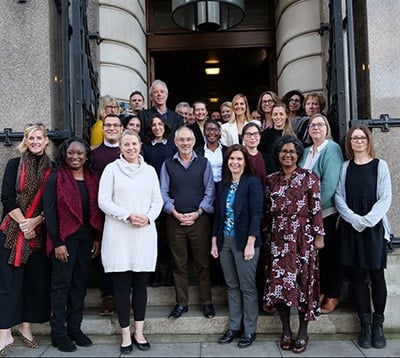Breast cancer survivors research
As part of our CUP Global work, we have released a new report that synthesises the latest evidence on diet, nutrition, physical activity and body weight.
This report also provides guidance for people living with and beyond breast cancer.
On this page
Background
Breast cancer is the most common cancer in women, with almost 2.2m new cases in 2022.
Progress in early detection and treatment has significantly increased the number of years lived after a diagnosis. Although survival rates differ between countries, there are an estimated 7.8m women worldwide who have survived at least 5 years after
a diagnosis of breast cancer. There is increasing demand for reliable, evidence-based guidance on diet and physical activity from health professionals and people living with and beyond cancer.
Evidence
Our research team at Imperial College London carried out a comprehensive analysis investigating the extent to which certain modifiable risk factors impact mortality (cancer-specific and all-cause), risk of cancer recurrence and health-related quality of life in women after a breast cancer diagnosis.
Four systematic reviews were carried out, analysing a total of 432 studies and an independent panel of experts graded the strength of the evidence from each review using our pre-determined criteria.

How we judge the evidence
Understand our criteria by which we evaluate the material we gather
Key findings
Quality of life
Overall, the results showed that physical activity improved quality of life. This was seen for global quality of life and specific quality of life domains (including physical and emotional functioning).
The evidence was less clear on how frequency and amount of physical activity made a difference to quality of life. There was some evidence that physical activity had a greater effect on quality of life when it was started after treatment compared with during treatment (treatment here refers to primary treatment and the acute phase of adjuvant treatment, not extended use of hormonal therapy).
The quality of the studies was assessed using the “Cochrane risk-of bias tool for randomized trials” (RoB 2). Overall, there were some issues with bias, but this was mostly due to the quality of life measures being self-reported and because it is not possible to blind participants to their intervention allocation.
These are both common issues with these types of trials and the use of validated tools to measure quality of life goes some way to addressing this. There was some variation (heterogeneity) in the findings, but overall, there was a positive effect.
There was little evidence of publication bias – this is when the results of a study influences whether or not it should be published, rather than just distributing it, regardless of the outcome.
Our Recommendation is that breast cancer survivors should be encouraged to be physically active.
Health-related outcomes
Body weight and risk of death and other outcomes after a breast cancer diagnosis
Our review included a number of risk factors related to body weight: body mass index (BMI), waist circumference and waist to hip ratio. For all 3 measures, higher levels are generally linked to greater health risks.
We found few studies that looked at the effect of BMI change or weight change, and those findings were not clear.
- We found strong evidence that a higher BMI, waist circumference, and waist-hip ratio after diagnosis increases the risk of death.
- We found some limited evidence that a higher BMI, waist circumference, and waist-hip ratio after diagnosis could increase the risk of breast cancer recurrence.
For every 5-point (kg/m2) increase in BMI, the risk of dying of any cause was estimated to increase by 7%.
The risk of dying from breast cancer was estimated to increase by 10% and the risk of having a second primary breast cancer by 14% both for every 5-point increase in BMI (kg/m2).
Diet and risk of death and other outcomes after a breast cancer diagnosis
- We found some limited evidence that eating soy could reduce the risk of death. There was a 4% lower all-cause mortality risk for those consuming higher levels of isoflavone from soy foods, the equivalent of 2mg/day.
- We found some limited evidence that eating soy could reduce the risk of breast cancer recurrence.
- We found some limited evidence that eating more dietary fibre could reduce the risk of death. There was a 13% lower risk of all-cause mortality for each 10g/day increase in fibre intake.
- We found some limited evidence that healthy eating patterns could reduce the risk of death.
Physical activity and risk of death and other outcomes after a breast cancer diagnosis
- We found some limited evidence that women who were more physically active had a reduced risk of death after a breast cancer diagnosis than women who did less physical activity. The most active women had an estimated 44% reduced risk of all-cause mortality and 42% reduced risk of breast cancer mortality.
- We found some limited evidence that physical activity could reduce the risk of breast cancer recurrence.
Summary of our guidance
This represents the evidence and corresponding guidance for each exposure
General guidance
Our recommendations for cancer prevention
Nutritional factors and physical activity appear to predict outcomes in people living with and beyond cancer, but there is insufficient evidence that changing these improves outcomes.
We suggest that people consider following as many of our cancer prevention recommendations as they are able to.
New specific recommendation on physical activity
Physical activity
Increasing physical activity improves health-related quality of life after a diagnosis of breast cancer. People who are more physically active have better health outcomes, but it is uncertain whether increasing physical activity will improve health outcomes.
We recommend that people are physically active. However, physical activity should be increased under the supervision of health care professionals.
New specific guidance on diet and body weight
Dietary fibre
People who eat more dietary fibre have better health outcomes after a diagnosis of breast cancer. But it is uncertain that increasing dietary fibre improves these outcomes.
We suggest that people consider increasing their dietary fibre intake.
Soy
There is limited evidence suggesting that people who eat more soy foods have better health outcomes after a diagnosis of breast cancer. There have previously been concerns over soy foods increasing the risk of developing breast cancer, but systematic reviews show no consistent evidence of a link between soy foods and breast cancer risk.
The current evidence does not support guidance to consume more soy foods (or to introduce soy foods if these are not currently part of the diet) after a diagnosis of breast cancer, but for those who already consume them, there is no need to stop.
Vitamin D
This review found limited evidence suggesting that those with higher vitamin D status have better health outcomes after a diagnosis of breast cancer, but there was no evidence of any benefit from vitamin D supplements.
We are not making specific guidance about vitamin D supplements to improve outcomes after a breast cancer diagnosis.
Body weight
Those with body weight in the ‘healthy range’ after a diagnosis of breast cancer have the best health outcomes. But it is uncertain that deliberate weight loss by people with overweight or obesity improves these outcomes.
We suggest that people who are not underweight aim to avoid gaining weight during and after treatment.
Read the full research

Experts we work with
We collaborate with world-renowned experts to assess every aspect of CUP Global